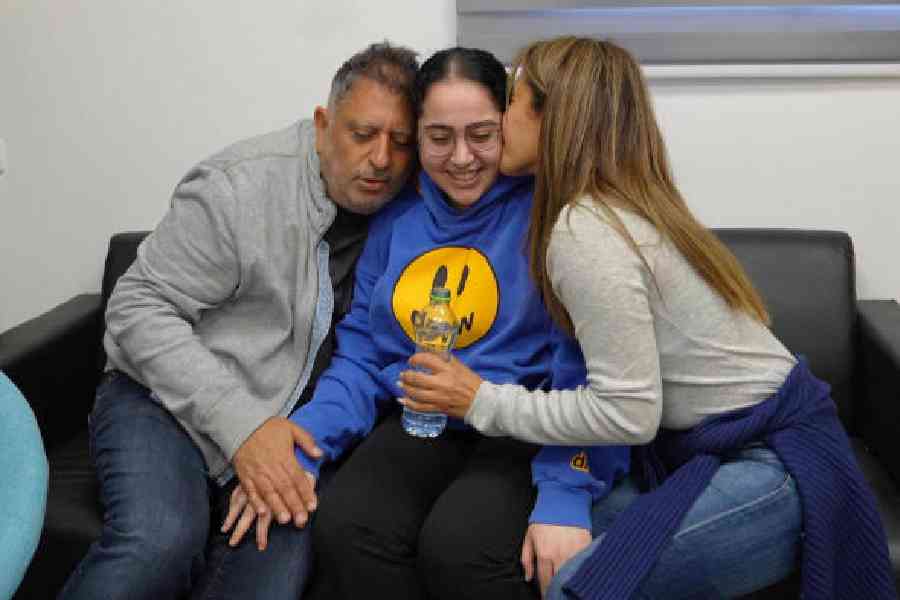The Israeli Army lookouts were monitoring Hamas in Gaza across a security fence from a base in southern Israel. As it turned out, Hamas was also watching them.
The four women released by Hamas on Saturday after more than 15 months in captivity in Gaza are “spotters” for the army who were stationed in a small military base about a half-kilometre from the border.
In the first minutes of the Hamas-led dawn assault on October 7, 2023, gunmen burst through the fence and overran the base, Nahal Oz. Dozens of soldiers were killed, including 15 spotters. The gunmen also dragged seven lookouts — unarmed female conscripts in their late teens — onto trucks and drove them into Gaza. Some were still in their pajamas, some bloodied from wounds.
One of them, Private Ori Megidish, 19, was rescued three weeks later by Israeli forces. Another, Corporal Noa Marciano, 19, was injured in an Israeli airstrike and then killed by militants inside Gaza’s Shifa hospital, according to the military. Hamas said she died in the bombing.
Four of the remaining five, Naama Levy, Karina Ariev and Daniella Gilboa, who are now all 20, and Liri Albag, 19, were released on Saturday as part of a ceasefire deal providing for the release of scores of Palestinian prisoners, many of them convicted of killing Israelis. A fifth spotter, Agam Berger, is slated to be released in the coming days or weeks under that deal, which came into effect on January 19.
Levy, Berger and Albag were recent recruits who had arrived at the base less than two days before the attack. The Israeli military has not disclosed the rank of the captured soldiers.
The capture of the lookouts underscored what many Israelis view as the worst military, intelligence and governmental debacle in their country’s history. Their families are still waiting for a formal investigation into the fall of Nahal Oz.
Relatives and former lookouts said the women were on constant alert for the possibility of a cross-border raid, though they did not envisage anything on the scale of the one that happened.
“All the time, they told us there’d be a raid,” said Amit Yerushalmi, 22, a former lookout who served at the Nahal Oz base from December 2021 until about a week before the assault. But she said they had expected a localised event along the fence, like an attempt to abduct a couple of soldiers.
“We would joke about whose shift the raid would fall on,” Yerushalmi said.
In the months leading up to the assault, Yerushalmi said, there were growing signs of something afoot. She said the spotters saw convoys of 20 to 30 white pickup trucks filled with Hamas fighters driving along the border with increasing frequency, stopping occasionally and peering into Israel through binoculars. They would also put up drones a few times a day, Yerushalmi said.
The spotters reported the activity, she and several relatives of the other lookouts said, but were told by their superiors that their job was to be the eyes, not the brains, of the Israeli military. Their reports, they said, appeared to have been dismissed.
The Israeli military declined to comment on the specific claims, but said in a statement that it was “reviewing the events of October 7 and what preceded them” with the goal of deriving lessons for the continuation of the army’s operations.
When the attack came, thousands of Hamas-led gunmen and marauders burst through the fence and overran military bases, border villages and towns, as well as a music festival. About 1,200 people were killed in Israel that day, and another 250 were taken as hostages into Gaza, according to the Israeli authorities. The assault set off a 15-month war that has killed more than 46,000 Palestinians, Gaza health authorities say, and has left much of the coastal enclave in ruins.
It took hours for any back-up forces to arrive at Nahal Oz. The lookouts’ commanders were at a different base, farther from the border.
“I still don’t know what really happened there,” said Eyal Eshel, the father of Sergeant Roni Eshel, one of the 15 lookout soldiers killed at Nahal Oz. Eshel conducted his own research into the events and is pressing for a formal inquiry into the failures on that day. “I understood one thing,” Eshel said of the research he had done on the fate of the spotters. “Their abandonment and the disdain for them was so great.”
Israel’s military chief, Lieutenant General Herzi Halevi, announced his resignation this past week and said that before he departs, in March, the military would finalise the series of long-awaited internal inquiries into its failure on October 7.
New York Times News Service











